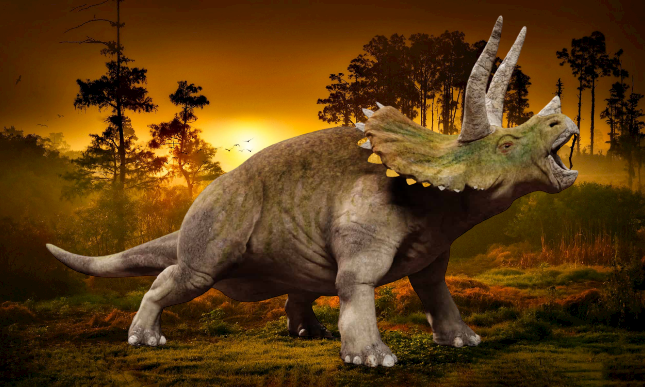Triceratops
The Triceratops or Tyceratops is a type of dinosaur that lives on Earth. It has a skull that is around a foot in length and is accompanied by a large postcranial skeleton. It is also classified into various species. It can be distinguished from other types of dinosaurs by its size and the way it is able to grow.
Triceratops
Table of Contents
One of the last non-avian dinosaur genera, Triceratops was a herbivore that lived during the late Maastrichtian stage of the Late Cretaceous. Its body was large, up to 30 feet long, with three horns, and its teeth were arranged in a series of batteries.
Its skull was a massive, horned head, which was one of the largest land animal heads in Earth’s history. Its snout was relatively small, but the frill was thick and bony. The skull was about a third of the length of the body.
Its rear limbs had four hooves, and its front limbs had five. Its teeth were arranged in a series of columns, with about three to five teeth per column.
Its jaws were huge, with three to five rows of teeth on each side. The teeth were stacked in “dental batteries,” forming a row of 36 to 40 tooth-loaded columns. This type of arrangement appears to have been used for shearing and for visual display, and probably for combat as well.
When it was first identified, it was thought to be a gigantic bison, but later discoveries revealed that it was a dinosaur. It was renamed Triceratops, which means “three horned face” in Greek.
Discovery and identification
Triceratops is an herbivorous chasmosaurine ceratopsid dinosaur that lived in the late Maastrichtian stage of the Late Cretaceous. It is found in western North America, primarily in the Laramidia area.
Typical features of Triceratops include a long bony frill on the back of its head, three horns, a short beak, and a snout with a conical frontal bone. The frill on the snout and horns on the snout may have been used for visual display or for species recognition. The horns were also likely used for communication.
The horns were made of keratin, which is a soft protein similar to human fingernails. Interestingly, Triceratops’ arms were not visible in the fossils. Perhaps they were scavenged by other dinosaurs.
Some Triceratops skulls reach lengths of up to seven feet. Their forelimbs had four hooves, while the rear limbs had three. Each jaw had 36 to 40 teeth per side.
Triceratops was one of the largest non-avian dinosaur genera. It could grow to about 12 to 30 feet long. It weighed up to 11,000 pounds. It was also known for its large skull, which had numerous small spikes on its frill.
Species
Triceratops was a large ceratopsian dinosaur, which lived during the late Jurassic period. It is one of the most iconic species of the dinosaur group and has been known from remains and fossils in Montana, Wyoming, and the Northwestern United States.
The skull of the Triceratops has three horns which rose up from its eyes. They may have been used to defend the animal from attacks by larger predators. They also may have been a means of impressing females. The horns were also thought to have served as display structures. The horns evolved during the animal’s life. The Triceratops skull is also unique because it is proportionately large. The horns are attached to the edge of the frill and sometimes have small pointed bones which are placed to the front of the frill.
The Triceratops skull is composed of twelve dorsal vertebrae. It also has three horns which are connected to the frill by small pointed bones. The horns are arranged in a pyramidal pattern on the skull. The skull is about a third of the total body length. The horns can reach over three feet long.
Synonyms and doubtful species
The name Tyrannosaurus rex is often used to describe two different species. These species are morphologically distinct and the holotype of one is the holotype of the other. However, there is some debate as to which is the correct name.
Triceratops is a genus of ceratopsids known from the Late Cretaceous period of North America. It has characteristics of other genera in the family Ceratopsidae, such as the Centrosaurinae. It has been identified as one of the best-known dinosaurs in the world.
The earliest Triceratops fossils come from the Laramie Formation. More recent finds have been found from the Lance and Evanston Formations in Colorado and the Denver Formation in Wyoming. Some specimens have been discovered in Hell Creek Formation, although none were able to be assigned a specific species.
There are other ceratopsids that are not represented by fossils. These include the shanshanosaurine genus Stygivenator, which has long, dental teeth. In addition, ankylosaurians are abundant in Hell Creek. There are also true birds, such as Avisaurus, found there.
There are several pachycephalosaurians in the Hell Creek Formation. These include Brodavis, Anzu, and Richardoestesia.
Size Skull
Triceratops is a huge, three-horned dinosaur with a large head. It lived in western North America in the late Cretaceous period. It was a herbivore and a strong predator. It is considered to be the largest ceratopsid in the world. It is estimated to have been around eight to nine meters long and up to 12 tons in weight.
The Triceratops skull is one of the most famous skulls in dinosaur history. In fact, it is the largest skull of any land animal. Unlike other large land animals, such as the Tyrannosaurus rex, which has a flat head, the Triceratops had a tall, bony frill on its head that protected the horns. The frill could reach three feet wide, which helped to fend off the attacks of other large animals.
Triceratops is part of the Ceratopsidae family, a group of land animals that includes Styracosaurus and Velociraptor. The name “triceratops” is derived from the Greek word for three horns. The Triceratops name is also related to the mythical battles that occurred between it and the rex.
Postcranial skeleton
The postcranial skeleton of Triceratops is not complete. However, new specimens of Pentaceratops and Titanoceratops are showing large openings, which suggests that these animals had larger skulls than previously thought.
Using a collection of over 100 new Triceratops from the Hell Creek Formation of Montana, the Museum of the Rockies has analyzed the details of the fusion of the skulls. The morphology of each skull is unique, revealing a variety of individual variation.
In addition to the skulls, the proximal expansion of the humerus, the ventral surface of the sacrum and the morphology of the dorsosacral ribs are all important indicators of taxonomic variation. These data were used to classify the specimens into growth stages, based on the cranial development.
One of the most complete skeletons of any dinosaur ever found is the skeleton of Ernanodon anterior, which was deposited in the Paleocene Epoch in Mongolia. It was the largest terrestrial vertebrate skull ever discovered and provides insight into the body proportions of the horned dinosaur.
Other important postcranial specimens are the skeletons of Torosaurus. The skulls of this species ranged from young to old adults. They have ten to twelve exoccipital, but no midline exoccipital.
Classification
Triceratops is a horned dinosaur with a frill of small spikes. It is known from specimens from western North America. The species was named by Othniel Charles Marsh in 1889. It is the most commonly known of all ceratopsian dinosaurs.
Triceratops was a large quadrupedal herbivore. It specialized in grazing low growing vegetation. It had a hefty body and weighed around 13 tons. It had three conspicuous horns. These horns were about 3 feet long. It also possessed a blunt nose horn. It may have used these horns to strike down taller plants with its beak or bulk.
This dinosaur is one of the most abundant in North America during the Late Cretaceous. It is found in Laramidia, which is now Western North America. The genus was originally considered a synonym of Diceratus. However, it is now classified as a chasmosaurine ceratopsian dinosaur.
The skull is proportionately large. It has an anteromedial process on the nasal process. It also has an open frontoparietal fontanelle. It possesses well-developed brow horns. It has a rostrum that is just under a third of the total body length.
Paleontology
Triceratops is a genus of herbivorous dinosaurs that lived in North America during the late Cretaceous Period. The Triceratops went extinct 65 million years ago. Several Triceratops fossils have been found in Canada and the United States. The horns that these animals possess may have enabled them to knock down plants that were taller.
These Ceratopsians reached their evolutionary peak during the Campanian Age of the Late Cretaceous. There were dozens of species that inhabited Asia and North America. The earliest known Ceratopsian is the Yinlong, which is from the Jurassic.
In the last few decades, there has been much research on the Triceratops ancestors. One of the main focuses is on the skulls. Scientists have found that the skulls of the oldest specimens are not as mature as those of the more recent ones. In addition, they have discovered bite marks on the bones. This helps to piece together the evolutionary puzzle.
The Hell Creek Project in northeastern Montana has a relatively detailed stratigraphic record for Triceratops. This includes two specimens. The skulls of these older specimens lack the frills that would have transformed the muscle attachment structures in the body.



